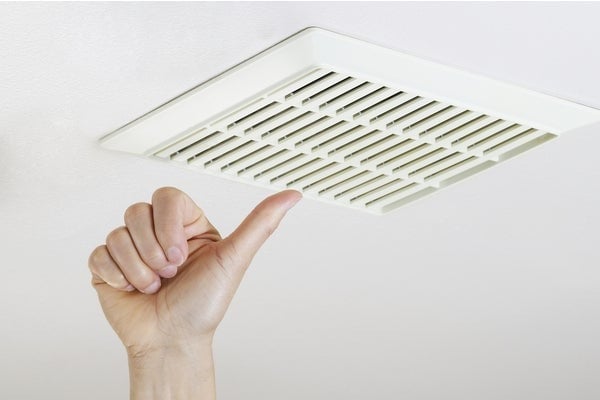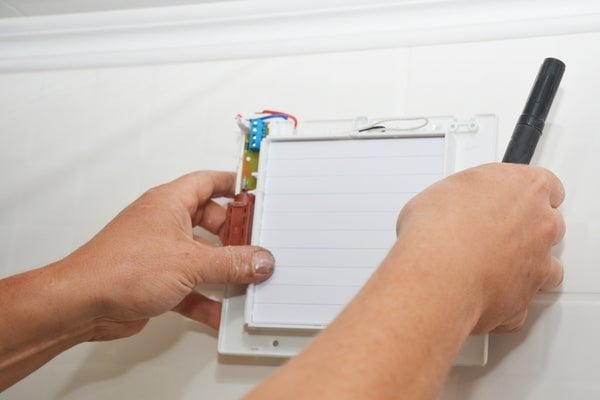How to Replace or Install a Bathroom Exhaust Fan: DIY Step-by-Step

American Home Shield gives a step-by-step guide to bathroom fan installation or replacement. Learn more about how to fix your bathroom fan.


American Home Shield gives a step-by-step guide to bathroom fan installation or replacement. Learn more about how to fix your bathroom fan.
You might be surprised to learn that installing or replacing a bathroom exhaust fan is a moderately easy DIY project. All you need are the right tools, basic electrical and carpentry skills, and a little patience. Follow these steps for how to install a bathroom fan or replace it.
Bathroom exhaust fans remove moisture and foul odors and prevent mold and mildew from growing in bathrooms. They can also keep wallpaper and paint from blistering and peeling and prevent doors and windows from becoming warped. So if your bathroom doesn’t have a fan—or if you’re considering a bathroom remodel—it’s recommended that you put one in. According to HomeAdvisor, the cost to install a bathroom fan with a contractor can be as much as $800, whereas installing it yourself can cost up to $370 plus the price of tools. So, not only will this guide teach you something new, but it could also save you a little money.
Grab your tools because this step-by-step guide will review how to install a bathroom fan and how to replace a bathroom fan.
Prepare to Install Your Bathroom Fan

Before beginning a bathroom exhaust fan installation, you’ll need to gather the following pieces of information and answer a few questions first to make sure you’re buying the right fan for your space.
1. Calculate your bathroom’s CFM rating.
Calculate the CFM (cubic feet per minute) of your bathroom. Multiply the room's cubic footage (length x width x height = cubic footage) and divide that number by 7.5. Doing this calculation will help you determine the appropriate strength needed for your fan.
2. How quiet do you want your new bathroom fan to be?
A loud bathroom exhaust fan venting can make a relaxing shower, well, not so relaxing. Sound ratings on newer bathroom fans range between 0.5 (very quiet) and 6 (very loud). When choosing an exhaust fan, aim for a rating of 1 or less for the least disruption; though, a fan with a rating of 2 or 3 shouldn’t be too loud.
3. Where do you want to install the new bathroom fan?
The placement of the fan can impact ventilation. The best spot for a bathroom fan installation is at the center point between your shower and toilet.
4. Gather materials and supplies.
Before starting your DIY bathroom fan installation, make sure you have all the tools and materials you need.
You’ll want to assemble these tools before you begin:
You’ll need these materials:
How to Install a New Bathroom Exhaust Fan

Now that you have your tools and materials, you can start your bathroom vent installation. Let’s get started!
1. Drill a reference hole and mark the ceiling.
2. Cut a hole in the ceiling for the intake port.
3. Put the exhaust fan in position.
4. Secure the fan to the joists.
5. Find an exit point for the duct pipe.
6. Attach the vent cap.
7. Wire the connections in the housing unit.
Depending on the type of fan, you may need to wire the connections from the attic or the bathroom. Read the manufacturer's instructions and check that the power is off before you start.
8. Attach the grille.
Great job! Now your bathroom will be properly ventilated.
A protection plan keeps your home well-ventilated with built-in exhaust fan coverage.

How to Replace an Existing Bathroom Exhaust Fan
If you just need to replace an existing bathroom exhaust fan, you’ll find it a little easier since you don’t need to cut holes in the ceiling or roof (phew!). Here’s a quick run-down of basic bathroom exhaust fan replacement.

1. Turn the electrical power to the bathroom OFF at the circuit breaker.
2. Get under the grille to unplug and disconnect.
If all you need to do is replace the bathroom fan motor, this is where you’ll stop. Bring the current motor to your hardware store to ensure you buy the correct model, then install it, reattach the wires, and put the grille back on. Want to know how to clean the grille? Check out our bathroom cleaning hacks.
3. Detach the housing unit in the attic.
4. Install the new replacement fan.
If your new bathroom vent fan is the same size as your old one, you can install it right away. If it’s bigger, you’ll have to cut a larger hole with a drywall saw. If it’s smaller, you can caulk around the edges of the housing unit to fill in the gaps once the fan is installed.
5. Connect the duct.
Once the bathroom vent fan is in place, attach a 90-degree duct elbow to the fan's exhaust port using sheet metal screws. Then, attach a new 4- to 6-inch (10.2 to 15.2 cm) duct pipe to the duct elbow.
6. Connect and secure the wiring.
7. Plug in and reattach the fan grille.
Go back to the bathroom and install the motor blower assembly by plugging it into the receptacle and screwing to secure. Then, attach the grille. Test out your new bathroom vent fan by turning the power back on.

Congratulations! Now you know how to install bathroom fan, which will keep your bathroom clean and dry and protect it from mold and mildew. For the ultimate protection, consider getting a home warranty with electrical coverage from American Home Shield. We offer home systems coverage for up to 23 essential systems and appliances—including built-in bathroom exhaust fans—to protect your household and your budget from inevitable breakdowns. Learn more about our home warranty and our affordable warranty prices to choose the coverage that works best for you.
AHS assumes no responsibility, and specifically disclaims all liability, for your use of any and all information contained herein.
Have a plan for your home when things don't go according to plan
Shop Home Warranties